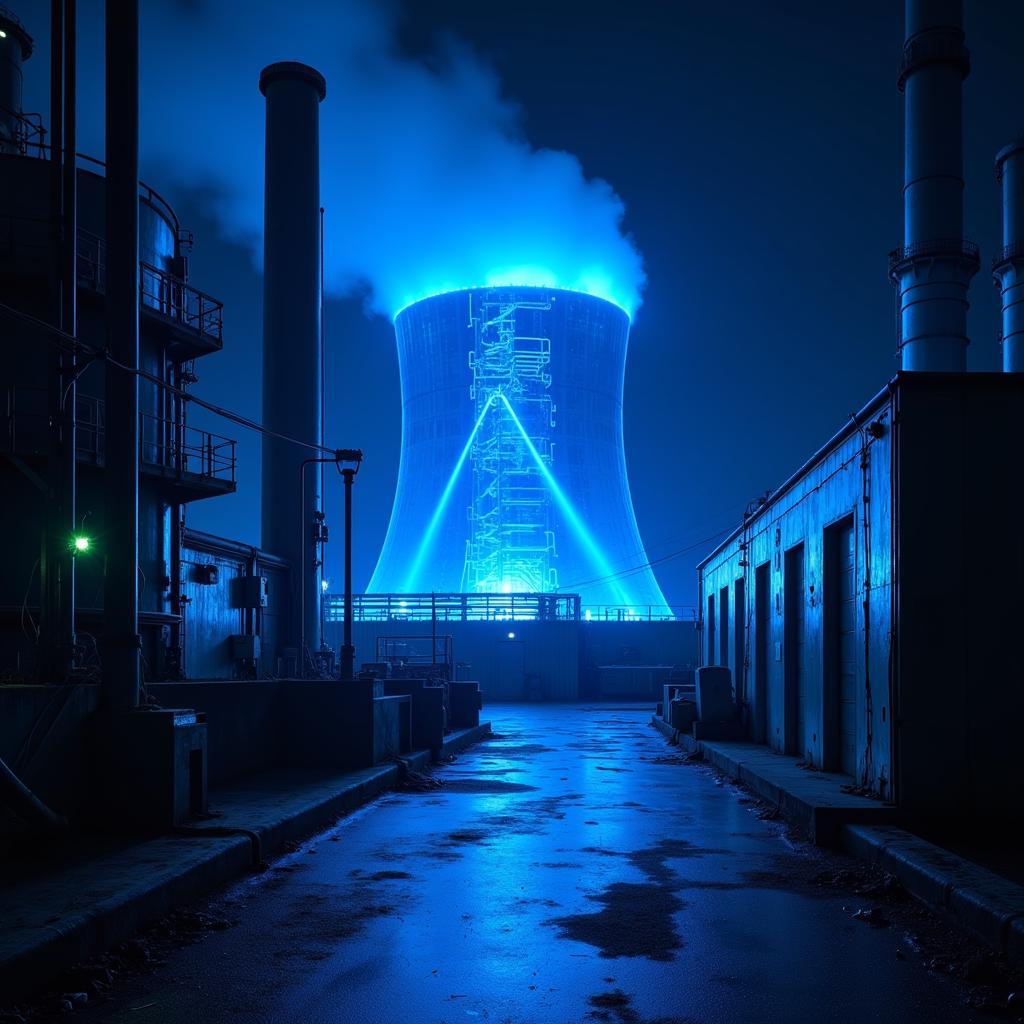Radioactive waste comes in various forms and, surprisingly, a range of colors. While often depicted as glowing green in popular culture, the actual appearance of radioactive waste is far more complex and depends on several factors, including the type of waste, its chemical composition, and its physical state. Understanding What Color Is Radioactive Waste can help dispel common misconceptions and provide a more accurate picture of this important environmental concern.
Unraveling the Hues of Radioactive Waste
The color of radioactive waste can be anything from clear and colorless, like water, to vibrant yellows, oranges, and even deep blues and purples. The stereotypical glowing green is often a result of Cherenkov radiation, a phenomenon that occurs when charged particles travel through a medium faster than light can in that medium. This can produce a blue glow, often perceived as green. However, this is not a characteristic color of all radioactive waste.  Cherenkov Radiation Blue Glow in Nuclear Reactor
Cherenkov Radiation Blue Glow in Nuclear Reactor
The most common types of radioactive waste, low-level waste (LLW) and intermediate-level waste (ILW), often appear similar to ordinary trash. This can include contaminated tools, protective clothing, and other materials used in nuclear facilities. These materials might not exhibit any visible difference in color from their non-radioactive counterparts. High-level waste (HLW), on the other hand, consists of spent nuclear fuel and other highly radioactive materials. These are typically stored in solid form or dissolved in liquids, and their color can vary depending on the chemical composition of the waste.
The Chemistry of Color in Radioactive Waste
The chemical composition of radioactive waste plays a significant role in its color. Uranium, for example, can form compounds with vivid yellow or orange hues. Other radioactive elements, like plutonium, can produce compounds with varying colors depending on their oxidation state. These color variations are often due to the way different elements and compounds absorb and reflect light.
Moreover, the physical state of the waste also impacts its appearance. Liquid radioactive waste can be clear, colored, or even cloudy, depending on the dissolved substances. Solid radioactive waste can range from metallic grey to various other colors, determined by the composition of the waste itself.
Debunking the Myth of the Glowing Green Waste
The perception of radioactive waste as glowing green likely stems from depictions in science fiction movies and comics. While Cherenkov radiation can produce a blue glow, this is not a universal characteristic of all radioactive materials. The color green is often used for dramatic effect and to visually signify danger. what color is nuclear waste This popularized misconception can lead to inaccuracies in understanding the real nature of radioactive waste.
Why Understanding the True Colors Matters
Knowing the true colors of radioactive waste is crucial for several reasons. It helps in accurate identification and handling of these materials, ensuring proper safety measures are taken. It also helps in dispelling misconceptions and promoting a more informed public understanding of nuclear waste management. Accurate information can alleviate unnecessary fears and facilitate informed discussions about the safe disposal and storage of these materials.
Conclusion
The color of radioactive waste is not a fixed characteristic, but rather a variable depending on several factors including the type of waste, its chemical composition, and physical state. While the stereotypical glowing green image persists in popular culture, the reality is far more nuanced. Understanding the true colors of radioactive waste helps in promoting a more accurate and informed understanding of this important environmental issue. what color is nuclear waste For further information and assistance regarding color choices and home design, contact Color Box Hanoi at 0373298888, email [email protected], or visit our showroom at 86 Cau Giay, Hanoi. Our 24/7 customer service team is ready to help you.
FAQ
-
Is all radioactive waste green?
No, radioactive waste can be various colors depending on its composition and state. -
What causes the blue glow sometimes associated with radioactive waste?
Cherenkov radiation, a phenomenon occurring when charged particles move faster than light in a medium, can cause a blue glow. -
What are the common colors of radioactive waste?
Radioactive waste can be colorless, yellow, orange, blue, purple, or even resemble ordinary trash. -
Why is it important to understand the true colors of radioactive waste?
Accurate identification and handling, as well as informed public understanding, rely on knowing the true colors of radioactive waste. -
Where can I learn more about radioactive waste management?
Numerous online resources and government agencies provide information on radioactive waste management.
Kêu gọi hành động: Khi cần hỗ trợ hãy liên hệ Số Điện Thoại: 0373298888, Email: [email protected] Hoặc đến địa chỉ: 86 Cầu Giấy, Hà Nội. Chúng tôi có đội ngũ chăm sóc khách hàng 24/7.

